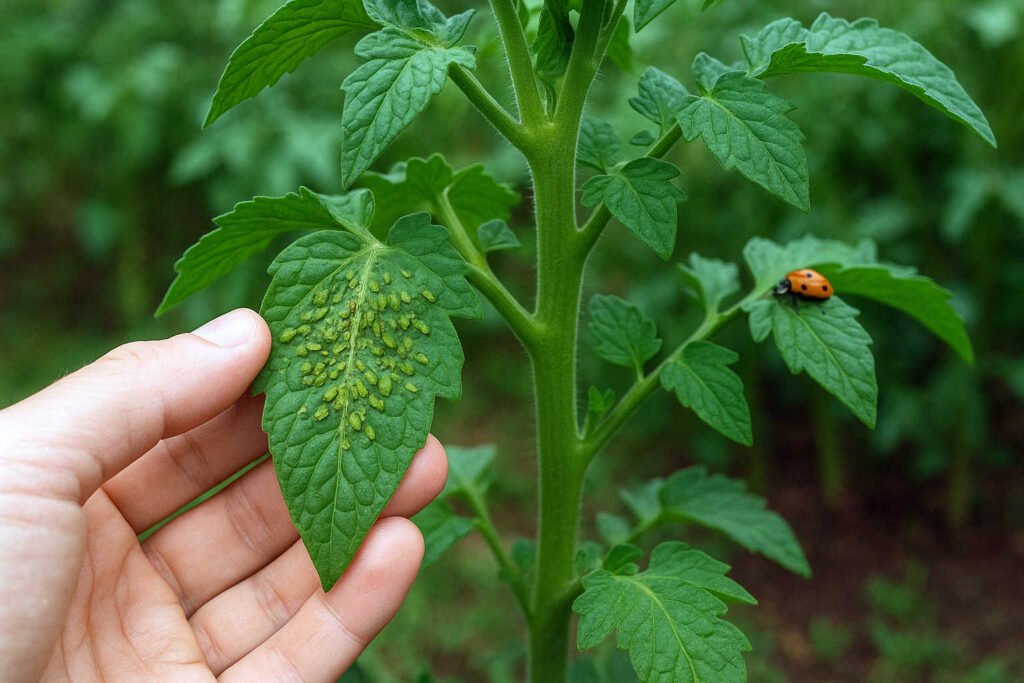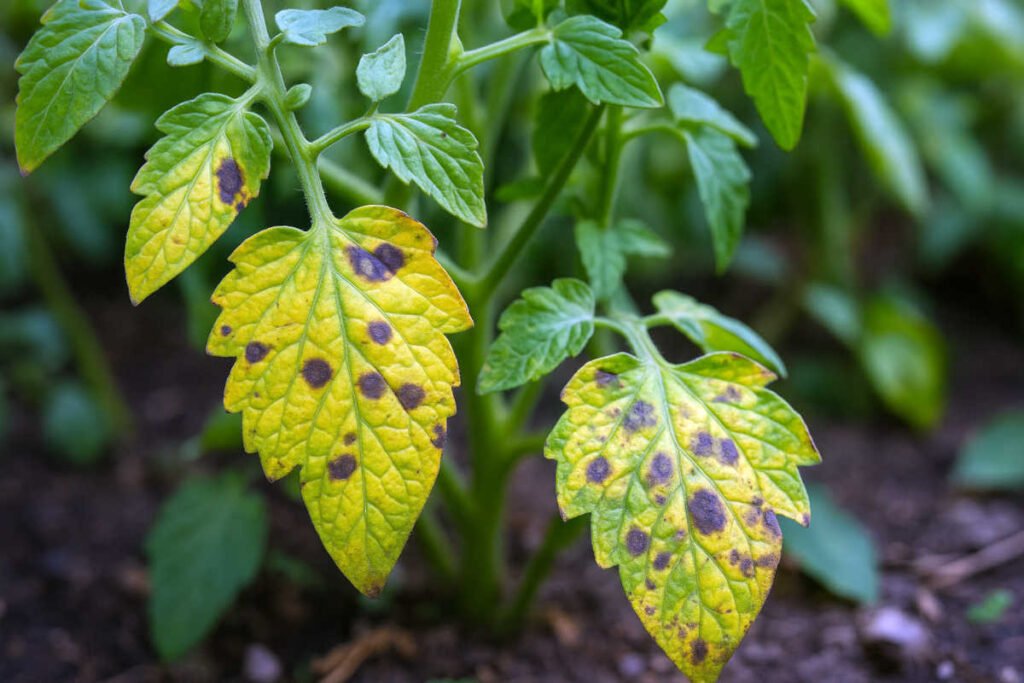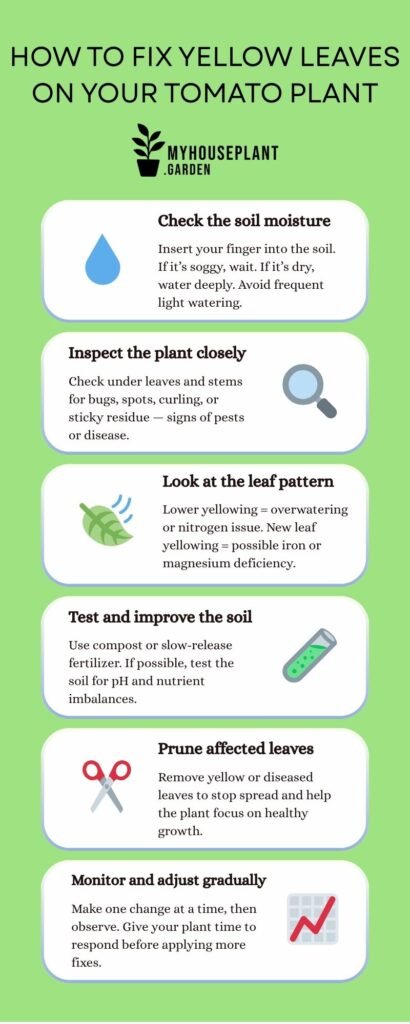You’re not alone if you’ve caught yourself wondering, “Why are my tomato plant leaves yellow?” It’s a common issue, and it can mean a lot of things. Sometimes, it’s harmless. Other times, it’s your plant crying for help.
In this post, you’ll learn the 9 most common reasons tomato leaves turn yellow, how to figure out what’s going on in your case, and—most importantly—what you can do to fix it before it gets worse.
Let’s make sure your tomato plant not only survives, but thrives.
Why Are My Tomato Plant Leaves Yellow?
Yellow tomato leaves usually mean that something’s off—like too much or too little water, a lack of nutrients, or poor sunlight. Sometimes it’s nothing serious. Other times, it’s an early warning sign that your plant’s in trouble and needs your attention.
That yellowing could start at the bottom, hit the newest leaves, or show up as random spots. Each pattern tells a different story. Before jumping into panic mode (or grabbing fertilizer), let’s break down what might actually be going on—and how to figure it out.
You may also like:
- 7 Plants That Attract Dragonflies and Keep Mosquitoes Away Naturally
- The Spider Plants Guide: Benefits, Planting, and Maintenance
The 9 Most Common Reasons for Yellow Tomato Leaves
1. Overwatering or Poor Drainage

Too much water is one of the top reasons tomato leaves start turning yellow. It drowns the roots and blocks oxygen, which the plant needs to breathe—yes, roots “breathe” too.
How to tell: Lower leaves look soft and yellow. The soil feels wet even days after watering. You might even spot mold or fungus.
How to fix it: Ease up on watering. Stick your finger about 2 inches into the soil—if it’s still moist, wait. If the pot has no drainage holes, that’s a red flag. Add them, or repot using better-draining soil.
2. Underwatering
On the flip side, not giving your tomato plant enough water can stress it out—and guess what? Yellow leaves show up here too.
How to tell: Leaves might be dry or crispy on the edges. The soil feels bone-dry. The plant looks weak overall, and wilts between waterings.
How to fix it: Water deeply, but not constantly. Let the water soak through the pot or garden bed. Then wait until the top inch or two of soil dries out before watering again.
3. Lack of Sunlight
Tomatoes are sun lovers—no two ways about it. Without at least 6–8 hours of direct sunlight per day, your plant starts losing steam.
How to tell: Leaves turn pale or yellowish. The plant grows slowly or becomes leggy (too tall and thin). Fruit production drops.
How to fix it: Move your plant to a sunnier spot if possible. If it’s indoors, place it near a south-facing window or use grow lights. In the garden, make sure nearby plants aren’t casting too much shade.
4. Nutrient Deficiencies
Tomato plants are hungry. If they’re missing key nutrients, they’ll show it—loud and clear—through yellowing leaves. But not all yellow leaves mean the same deficiency.
How to tell: It depends on the nutrient. Here’s a quick breakdown:
- Nitrogen deficiency: Lower leaves turn yellow first. Plant growth slows down.
- Magnesium deficiency: Yellowing appears between the leaf veins, but veins stay green.
- Iron deficiency: Newest leaves at the top go yellow, while veins remain green.
How to fix it: Use a balanced tomato fertilizer that includes micronutrients like magnesium and iron—not just NPK. Test your soil if possible. You can also apply Epsom salt (for magnesium) or chelated iron depending on the problem.
| Nutrient | Symptoms | Where It Shows First | How to Fix It |
| Nitrogen | Lower leaves turn yellow uniformly; slow growth | Old (lower) leaves | Apply balanced fertilizer or compost |
| Magnesium | Yellowing between veins; green veins remain visible | Older leaves, middle of plant | Use Epsom salt (magnesium sulfate) diluted in water |
| Iron | New leaves turn yellow with green veins | Young (top) leaves | Apply chelated iron; adjust soil pH if too high |
| Potassium | Yellow edges and brown leaf tips; weak stems | Leaf edges and tips | Use potassium-rich fertilizer |
| Calcium | Yellow patches; blossom end rot on fruit | New leaves and fruit | Add calcium via lime or calcium nitrate |
| Phosphorus | Leaves may turn dark with a purplish tint | Older leaves | Use phosphorus-rich fertilizer (e.g., bone meal) |
Table: Common Nutrient Deficiencies in Tomato Plants
5. Pest Infestations

Pests don’t always come with flashing signs—but they do leave marks. Some feed on the leaves, some suck the juices out of the stems, and all of them mess with your plant’s health.
How to tell: Check under the leaves. Look for tiny bugs (like aphids, spider mites, or whiteflies), small holes, or sticky residue. Leaves may yellow in patches or curl.
How to fix it: Use insecticidal soap or neem oil to treat mild infestations. For heavier problems, prune infested leaves and isolate the plant if it’s in a pot. Consistency is key—repeat treatments every few days.
6. Fungal or Viral Diseases

Sometimes yellow leaves signal something more serious—like a disease. Fungi and viruses can hit tomato plants hard, especially in humid or overcrowded conditions.
How to tell: Fungal diseases (like Septoria leaf spot or Fusarium wilt) usually start as yellow spots with brown centers. Viral infections may cause mottling, distorted growth, and widespread yellowing.
How to fix it: Remove infected leaves right away. Don’t compost them. Improve air circulation, avoid overhead watering, and disinfect pruning tools. For viral infections, there’s no cure—remove the whole plant to protect others nearby.
7. Transplant Shock
Just moved your tomato plant to a new spot? It might not be happy about it. Transplant shock is real—and yellowing leaves are a common side effect.
How to tell: The yellowing shows up within a few days after transplanting. The plant may look wilted or “stunned,” as if it paused growth altogether.
How to fix it: Keep the soil moist (but not soggy), protect the plant from intense sun for a few days, and don’t fertilize right away. It needs time to adjust. Most plants bounce back within a week or two.
8. Compacted or Poor Soil
If your soil feels like clay or dust, your tomato’s roots are probably struggling. Compacted soil limits oxygen, drainage, and nutrient absorption—all of which can lead to yellow leaves.
How to tell: Water pools on the surface. Roots don’t grow deeply. You see stunted growth and pale leaves.
How to fix it: Amend your soil with compost, coco coir, perlite, or aged manure. These improve structure and nutrition. For potted plants, consider repotting with fresh, high-quality soil mix.
9. Natural Aging of Leaves
Not all yellow leaves are a crisis. Sometimes, it’s just your plant letting go of old growth to focus on new fruit and foliage.
How to tell: Lower leaves (especially near the base) turn yellow gradually and drop off. The rest of the plant looks healthy and productive.
How to fix it: No action needed—this is totally normal. You can prune the old leaves if they look messy or are touching the soil, just to improve airflow and tidiness.
You may also like:
- How to Protect Plants from Frost: 6 Proven Methods for a Healthy Garden
- Dragon Tail Plant Guide: How to Grow Epipremnum Pinnatum
How to Fix Yellow Leaves on Your Tomato Plant
To fix yellow tomato leaves, you need to find the cause first—then act fast. Check water levels, inspect for pests, improve soil, and remove damaged leaves.
Not sure where to start? Follow these steps:
- Check the soil moisture: Stick your finger 1–2 inches into the soil. If it’s too wet, let it dry out. If it’s bone-dry, water deeply. Avoid shallow, frequent watering.
- Inspect the plant closely: Look under the leaves and along the stems. Any tiny bugs? Spots? Curling? Sticky residue? These are signs of pests or disease.
- Look at the leaf pattern: Yellowing on lower leaves often means nitrogen issues or overwatering. Yellowing on newer leaves might signal iron or magnesium deficiency.
- Test and improve the soil: If your plant’s in a container, consider repotting. If it’s in the ground, add compost or a slow-release fertilizer. If available, use a soil test kit to check for nutrient imbalances and pH issues.
- Prune affected leaves: Remove yellow, dead, or diseased leaves with clean scissors or pruners. This helps prevent the spread of pests or fungi and lets the plant focus energy on healthy growth.
- Monitor and adjust gradually: Avoid doing everything at once. Apply one fix, wait a few days, and observe. Plants don’t respond instantly, but small corrections make a big difference.
Bonus tip: Use mulch to retain moisture and reduce soil splash—both of which protect leaf health long term.

You may also like:
- How to Grow Garden Sage at Home: Tips for Lush, Flavorful Plants
- How to Grow Kale: A Step-by-Step Guide for Healthy, Homegrown Greens
How to Prevent Tomato Leaves from Turning Yellow
The best way to deal with yellow tomato leaves? Keep them from turning yellow in the first place. Here’s how to stay ahead of the problem:
- Water consistently and deeply: Avoid extremes. Stick to a routine and always water at the base—not the leaves. Deep watering encourages strong root growth.
- Use quality soil and compost: Start with well-draining soil rich in organic matter. Compost improves texture, adds nutrients, and boosts microbe activity.
- Feed your plants regularly: Tomatoes are heavy feeders. Use a balanced fertilizer every few weeks—or choose a slow-release option. Don’t overdo it, though—too much nitrogen causes leafy growth, not fruit.
- Rotate crops every season: Don’t plant tomatoes in the same soil year after year. Rotating crops helps prevent soil-borne diseases and nutrient depletion.
- Give them room to breathe: Space your plants properly to allow airflow. Poor ventilation encourages fungal diseases that lead to yellow leaves.
- Mulch to stabilize soil moisture: A layer of mulch helps regulate temperature, prevent water loss, and block disease splashes from the soil.
- Keep an eye out—early: Do quick weekly inspections for pests, spots, or anything unusual. The sooner you act, the better the outcome.
Conclusion
If you’ve been asking, “Why are my tomato plant leaves yellow?”—now you’ve got answers. Yellowing can come from overwatering, nutrient issues, pests, or even just natural aging. The key is knowing what signs to look for, acting quickly, and giving your plant the care it needs.
Now that you know what’s causing it—and how to fix it—your tomatoes are on track to bounce back, stronger than ever.
FAQ: Tomato Plant Leaves Turning Yellow
1. What do yellow tomato leaves mean?
They usually signal a problem like overwatering, nutrient deficiency, or lack of sunlight—but some yellowing is normal in older leaves.
2. Should I remove yellow leaves from my tomato plant?
Yes, if they’re dead, diseased, or affecting airflow. Healthy green parts shouldn’t be removed.
3. Can yellow leaves turn green again?
Not usually. Once a leaf turns yellow, it rarely recovers. Focus on fixing the cause and supporting new growth.
4. Is it normal for bottom tomato leaves to turn yellow?
Sometimes. If the rest of the plant looks healthy, it’s likely natural aging. If not, check for overwatering or nitrogen deficiency.
5. What nutrient deficiency causes yellow tomato leaves?
It depends. Nitrogen, magnesium, and iron deficiencies are common culprits—each affects different parts of the plant.